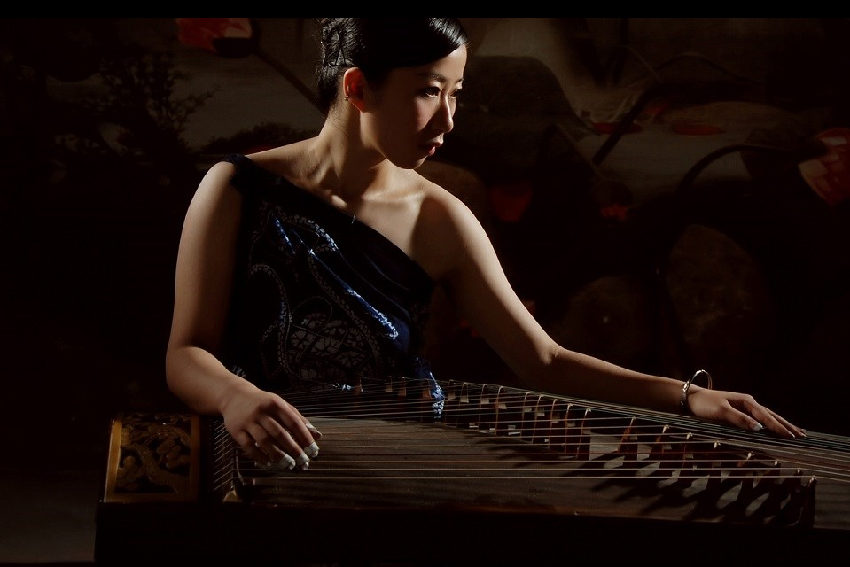OzAsia Review: Meeting Points

Featuring androids, traditional and electronic instruments and intriguing collaborations, the three-part program Meeting Points conquered musical, cultural and technological boundaries.
OzAsia seems set on a course of increasingly interesting and experimental music programming, and this year we have Meeting Points, a world premiere collaboration between the Australian Art Orchestra and musicians from China, South Korea, Australia and Japan.
The three-part program kicked off with Mindy Meng Wang’s Cocoon, a soaring, multidirectional composition for guzheng and chamber orchestra that commenced with a sense of Chinese tradition before launching into completely unexpected soundscapes.
Born in China and arriving in Australia by way of London, Meng Wang has studied the guzheng since the age of seven and pushes the instrument from its Chinese foundations into experimental and improvisational spaces.
Arranged and orchestrated by Australia’s Jem Savage, Cocoon coursed elegantly through genres. It was a yearning, lifecycle-like journey through ambient, chamber and jazz, with hints of big band, suggestions of Alice Coltrane and Charles Mingus, and at its most frenetic even something approaching free jazz, but always returned to recognisably Chinese reference points, anchored by the guzheng.
A versatile instrument that fits beautifully with the contra bass, the guzheng created a certain tone that, in repeatedly emerging from and dissolving into the landscape, was a thrilling foundation for this sophisticated work.
Second on the program was a truly unexpected and unforgettable collaboration, Seoul Meets Arnhem Land: Ecstatic Voice, which paired South Korean p’ansori master Bae Il Dong with Arnhem Land Yolngu manikay performer Daniel Wilfred.
P’ansori is a form of musical storytelling normally performed by a vocalist and a percussionist in a tradition stretching back centuries. In perfecting his craft, Bae has spent long periods singing into waterfalls in pursuit of tonal mastery.
Yolngu manikay is an Arnhem Land song series passed down the generations over thousands of years, and is one of the world’s oldest continuously practiced music traditions. From his base in Ngukurr, Wilfred lends his extraordinary voice to various ceremonial functions through his role in the Young Wägliak Group, and brought this ancient tradition to the OzAsia stage.
Supported by percussionist Simon Barker and vocalist Jenny Barnes, whose unconventional utterances and rasps offered an otherworldly counterpoint, Seoul Meets Arnhem Land: Ecstatic Voice was a haunting exhibition of pure vocal force, by turns raw, guttural and velvety, and built on unique notions of tone.
Each performer displayed motifs which offered structure to the work, and the combined sound was something beyond harmonies, something essential linked by jazz-like percussion and the warmth and playfulness between the performers.
The simultaneous expression of the two traditions never felt like a competition or a collision of approaches, but instead presented as something entirely new. Indeed, much of the joy of the piece was that the merging of such ancient traditions could produce something so avant-garde and compelling.
From the ancient to the futuristic, Keiichiro Shibuya’s Scary Beauty was the third work in the program. Featuring an android called Skeleton with its own neural network, a voice like a soft vocoder, and complete control over its own gestures and facial expressions, the work was striking and unsettling.
Shibuya is a Japanese artist based in Tokyo and Paris, whose collaborations with researchers, roboticists and fashion designers (Skeleton was wearing a garment by Sacai) have led to cutting-edge musical output.
Atop the Australian Art Orchestra’s gorgeously lush orchestration was a theme of artificial intelligence wrestling with identity. Singing the rather dark words of writers such as Yukio Mishima and Michel Houellebecq, and at times burbling a chilling, unintelligible ‘non-language’, the android’s performance was both existential questioning and also a reminder of the more frightening possibilities of artificial intelligence, were it to invent its own language and exclude humans from the dialogue.
The music again displayed evidence of jazz, electronica and improvisation, and the on-screen visuals and judicious lighting effects created a strange and wonderful multisensory experience.
Meeting Points was a terrific collaboration with an exhilarating breadth of vision. Its spirit of improvisation and sonic collaboration celebrated tradition; encouraged exploration and showcased our region of the world. Australian Art Orchestra artistic director Peter Knight describes the program as a “space for the development of new ideas and unrepeatable experiences for audiences”, which very sadly suggests that there may not be another opportunity to experience it.
Meeting Points was performed at Space Theatre on Saturday, September 30